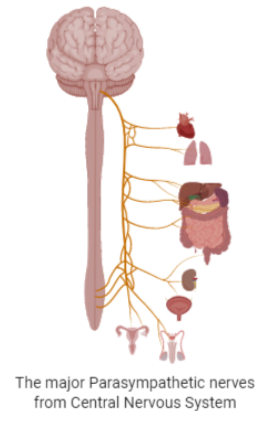
Which of the following cranial nerves is a parasympathetic nerve?
A. Facial
B. Auditory
C. Abducens
D. Accessory spinal
Answer
572.7k+ views
Hint: Parasympathetic nerves arise from the central nervous system. Parasympathetic nerves function when the body is at rest. Functions like tears, salivation in the mouth are performed by the parasympathetic cranial nerve for facial activities.
Step by step answer:The parasympathetic nervous system is regarded as part of the autonomic nervous system. It controls various activities like lacrimation (tears), salivation, sexual arousal, digestion, etc. when the body is at rest. The cranial nerves involved are the glossopharyngeal nerve, oculomotor nerve, vagus nerve, and facial nerve.

The facial cranial nerve controls the reflexes of tear generation and salvation in the mouth. This nerve functions by controlling facial glands and arises from the central nervous system under the parasympathetic branch.
The auditory cranial nerve is the part of the vestibulocochlear nerve. This cranial nerve relays auditory sensory information from the cochlea to the brain. This is not a parasympathetic nerve.
The abducens cranial nerve supplies the muscles causing side-to-side movement of eyeballs. It is not included in parasympathetic nerves. As it not only functions at rest but actively participates in fast and slow eyeball movements in an active state of the body.
The accessory spinal nerve has a somatic motor function in muscles. This means that it provides movement and no sensation. It originates from the upper part of the spinal cord and is not a parasympathetic nerve.
Thus, the correct answer is the Facial nerve, option A.
Note: The parasympathetic nerves with sympathetic nerves make up the Autonomous nervous system. The parasympathetic nervous system is different from the sympathetic nervous system as they function for ‘feed or breed’ and ‘flight or fight’ respectively.
Step by step answer:The parasympathetic nervous system is regarded as part of the autonomic nervous system. It controls various activities like lacrimation (tears), salivation, sexual arousal, digestion, etc. when the body is at rest. The cranial nerves involved are the glossopharyngeal nerve, oculomotor nerve, vagus nerve, and facial nerve.

The facial cranial nerve controls the reflexes of tear generation and salvation in the mouth. This nerve functions by controlling facial glands and arises from the central nervous system under the parasympathetic branch.
The auditory cranial nerve is the part of the vestibulocochlear nerve. This cranial nerve relays auditory sensory information from the cochlea to the brain. This is not a parasympathetic nerve.
The abducens cranial nerve supplies the muscles causing side-to-side movement of eyeballs. It is not included in parasympathetic nerves. As it not only functions at rest but actively participates in fast and slow eyeball movements in an active state of the body.
The accessory spinal nerve has a somatic motor function in muscles. This means that it provides movement and no sensation. It originates from the upper part of the spinal cord and is not a parasympathetic nerve.
Thus, the correct answer is the Facial nerve, option A.
Note: The parasympathetic nerves with sympathetic nerves make up the Autonomous nervous system. The parasympathetic nervous system is different from the sympathetic nervous system as they function for ‘feed or breed’ and ‘flight or fight’ respectively.
Recently Updated Pages
Master Class 11 Business Studies: Engaging Questions & Answers for Success

Master Class 11 English: Engaging Questions & Answers for Success

Master Class 11 Computer Science: Engaging Questions & Answers for Success

Master Class 11 Social Science: Engaging Questions & Answers for Success

Master Class 11 Maths: Engaging Questions & Answers for Success

Master Class 11 Biology: Engaging Questions & Answers for Success

Trending doubts
Differentiate between an exothermic and an endothermic class 11 chemistry CBSE

10 examples of friction in our daily life

One Metric ton is equal to kg A 10000 B 1000 C 100 class 11 physics CBSE

Difference Between Prokaryotic Cells and Eukaryotic Cells

State the laws of reflection of light

Explain zero factorial class 11 maths CBSE




